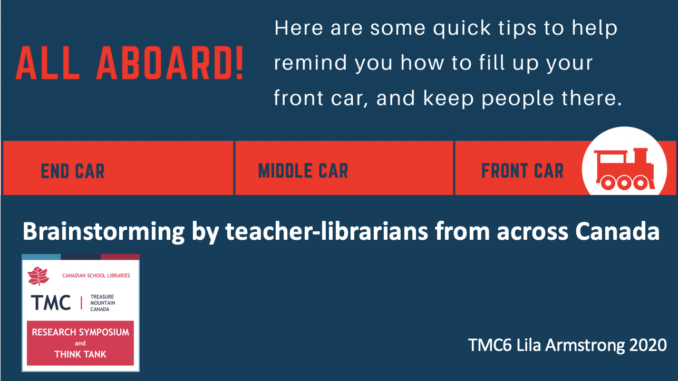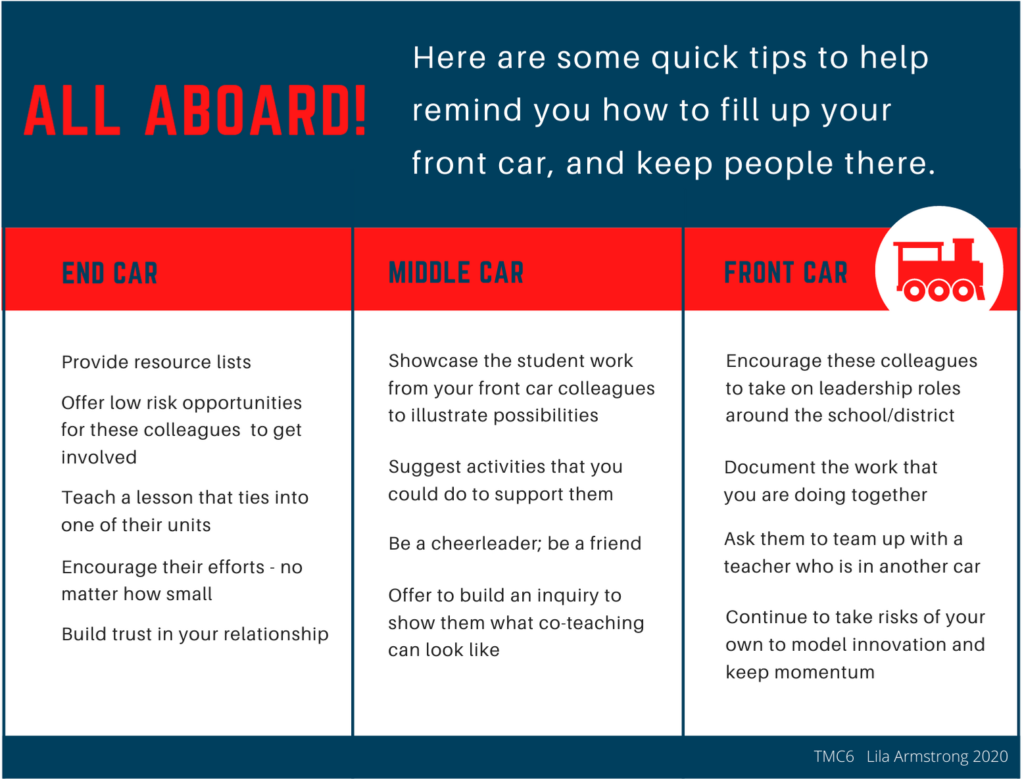
By Lila Armstrong
Collaboration
“Collaboration is a trusting working relationship between two or more equal participants involved in shared thinking, shared planning and shared creation of something new.”
(Montiel-Overall, 28)
Collaboration is no longer a library buzzword, it’s a widely accepted practice that has been studied furiously over the past few decades, with results consistently showing improved student learning, happier teachers, student-centred learning, increased motivation and positive effects on school culture and community (Vangrieken, 28). However, many teacher-librarians (TLs) are struggling to create the dynamic co-planning, co-teaching, and co-assessing structure that defines higher levels of collaboration.
Recent graduates of most post-graduate programs enter the teacher library position with excitement and grand plans of collaboration, only to find that the current practices at their school make this difficult. Veterans can just as easily find themselves in school where the culture is less open to innovation. According to Vangrieken, (“Teacher Autonomy”, 307) a few of the most common reasons stated as to why teachers find it difficult to collaborate include lack of time, a desire to maintain professional autonomy and a lack of administrator support.
Keep It Up
TL colleagues suggest that it takes about three years to get teachers on board with higher level collaboration in the library learning commons (LLC). However, these are active years in which a TL is working to lay the foundation for future success. While it can be frustrating when not everyone is keen to jump on board, there are two things to keep in mind: you are building relationships and literacy skills with your students every day; and TLs with experience can help guide you along the process of recruiting your colleagues and administration. Increasing your PLN and having some TL friends involved in your journey can provide you with support, too.
What train?
Raymond Nashar, creator of the video “How to Lead Innovation: The 3 Carriage Train,” compares the workplace to a train with three cars. In the front car is you, with a few trusted colleagues: you are the innovators. Behind you is the middle car, the most populated car, filled with colleagues who may be afraid to make the move forward, are not yet convinced that you are worth following, and who feel comfortable where they are. In the last car, are those who are actively resistant, the foot draggers.
It is important to find out where your Administration is in your train. Administrators can be your greatest ally, and if they need to be moved up to the front of the train, then apply all your skills to making sure that they are included in your plan.
On Board
The front car is fun! You are surrounded by people who think like you, like to work with you, and have similar teaching practices. It feels good to spend your time here, but really, your friends in the front car do not need much from you. The best thing that you can do for the people in the front car is to give them leadership roles. These leadership opportunities include but are not limited to sharing at staff meetings, professional development days, or collaboration sessions; contributing to school/library blog/newsletters; or co-leading a lunch and learn session. Not only does this validate their great work, but it catches the attention of our colleagues in the middle, and the administration.
When you are working with colleagues in the front car, document your progress, process, successes and failures. Believers will be more forgiving of failures, and it shows those in the back two cars that everyone is still learning. This resilience can not only make you more human to your students but make you a stronger and more empathetic leader.
“The library learning commons plays a key role in cultivating and facilitating collaboration to provide rich experiential learning experiences.”
Leading Learning
On the Platform
The middle car is quite full, but the jump into the first car might seem too far, or too hard, for even those with the best intentions. So how can you bridge this gap? As a motivated but thoughtful school leader, your job is to tip the platform in your direction.
You might start by creating bulletin boards to showcase student projects. Keep in mind that displaying the work of your on-board colleagues is an easy way for the platform group to understand what it is all about, while seeing the success of their non-TL peers. This is where exchanging ideas and building relationships becomes even more important: find out what they are teaching and pull books; suggest activities that you can do in the LLC that support their units; offer to build an inquiry plan and lead it, so that they get a feel for what co-teaching could look like. When you work with colleagues on the platform, it is important to be flexible, honest and open. You might get their interest piqued with technology, but trust and a common understanding of goals and barriers will get them in for the long haul. “Yes, and” should be at the ready, as well encouragement and feedback for the steps that they do take.
Once a few of the platform group start to make the jump, others will think that it is possible for them too.
Feet Draggers
Your colleagues in car three need low risk opportunities to try out what you are selling. These might include resource lists, involvement in a school wide initiative (that showcases teamwork/collaboration), using the LLC as a workspace for the class, or your help with a small group of students. Working with a TL in situations where there is no extra investment from the teacher highlights your willingness to meet them where they are and to offer your support at any level of the Teacher-Librarian Collaboration Model.
This is also a good time to call in an on-board ally to share successes and offer some collaboration or co-teaching ideas. You might also offer to teach a lesson in the library that ties into a unit of study – taking some teaching off their hands, and modelling what your involvement could look like. Perhaps they might notice where their style and yours overlap, or you might share your observations that they are already doing something great in their class that easily lends itself to further collaboration.
And no one minds a treat from time to time: cupcakes, a book delivery, or an unexpected shout out. Anyone who is feeling insecure about changing their routine, teaching practice, or incorporating technology for the first time is likely to feel a bit insecure, and your reassurance can go a long way in letting them know that you know what it feels like, and that you are a supporter.
All Aboard
Your efforts will not go unnoticed, although it may take time to lay the groundwork. As Nashar says, once more colleagues jump on the platform and into the front car, it becomes more “normal” and others will follow suit. Remember to give yourself some validation for your efforts; no matter how small your victories may be, they are victories all the same.
“Don’t let the train of enthusiasm run through the station so fast that people can’t get on board.”
H V Morton

Author’s Note
This article was created out of a brainstorming session by teacher-librarians from across Canada, who came together at TMC6 in Toronto, February 1, 2020. Credit for the suggestions listed in the article is shared between all of those who participated in the activity, designed to keep the momentum going in our school libraries.
tmc.canadianschoollibraries.ca/tmc6-2020/
References
Montiel-Overall, P. (2006). Teacher and Teacher-Librarian Collaboration: Moving toward Integration. Teacher Librarian, 34(2), 28–33.
Nashar, R. (2012, December 9). How to Lead Innovation: The 3 Carriage Train. Retrieved from https://www.youtube.com/watch?v=HEPinFBcBgU
Vangrieken, K., Dochy, F., Raes, E., & Kyndt, E. (2015). Teacher collaboration: A systematic review. Educational Research Review, 15, 17–40. doi: 10.1016/j.edurev.2015.04.002
Vangrieken, K., Grosemans, I., Dochy, F., & Kyndt, E. (2017). Teacher autonomy and collaboration: A paradox? Conceptualising and measuring teachers autonomy and collaborative attitude. Teaching and Teacher Education, 67, 302–315. doi: 10.1016/j.tate.2017.06.021

Lila Armstrong has been teaching in the K-8 classroom for over 10 years and recently moved into an immersion teacher-librarian position at École Willow Point Elementary in Campbell River, BC. She has a B.A. in Political Science, and a Masters of Urban Planning from McGill University, along with a B. Ed from the University of Ottawa. Lila was preparing for a life in politics but realized that teaching was her calling. She and her husband are raising two small readers, and one large Golder Retriever.
